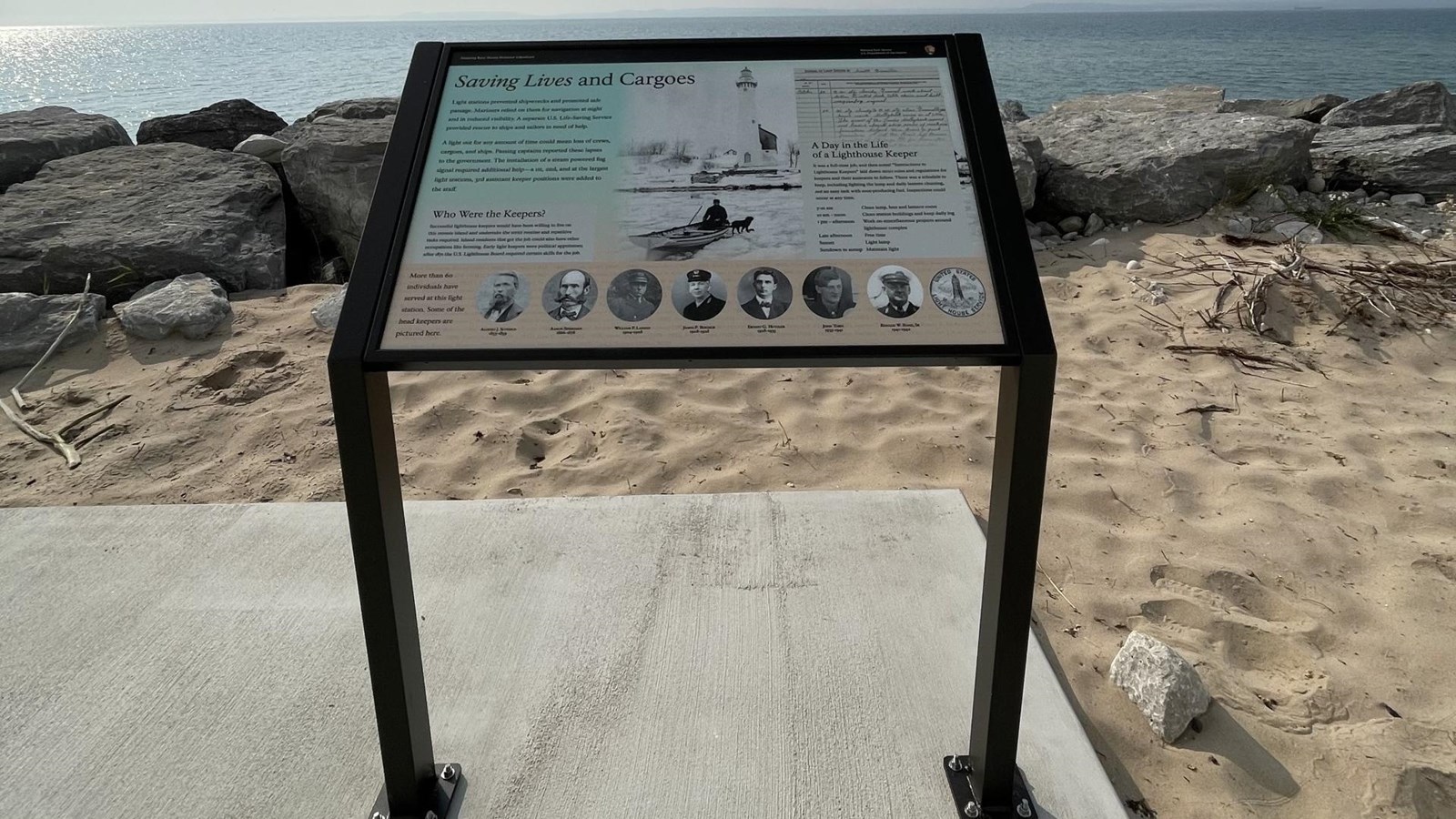Last updated: September 20, 2025
Place
Saving Lives and Cargoes - SMI Wayside

NPS M. Baughman
“Saving Lives and Cargoes” is a slanted outdoor panel thirty-six inches wide by twenty-four inches high and attached to a frame with brown metal legs. On the left side, black letters on a light blue background:
“Saving Lives and Cargoes”
Light stations prevented shipwrecks and promoted safe passage. Mariners relied on them for navigation at night and in reduced visibility. A separate U.S. Life-Saving Service provided rescue to ships and sailors in need of help.
A light out for any amount of time could mean loss of crews, cargoes, and ships. Passing captains reported these lapses to the government. The installation of a steam powered fog signal required additional help.---a 1st, 2nd, and at the largest light stations, 3rd assistant keeper positions were added to the staff.
In the center, a black and white photo of a man and a dog on the partially frozen lake near the shore. The man sits in a small rowboat, the black dog stands on the lake. White snow covers the lake and the land behind them as they face away from the Light Tower with the Keeper’s Quarters behind it.
On the left in a light yellow square “A Day in the Life of a Lighthouse Keeper”. On the top, is the Journal of Light Station at South Manitou. On the left are dates: October twenty-three and twenty-four. To the right are blurry hand written paragraphs. Below:
“A Day in the Life of a Lighthouse Keeper”
It was a full-time job, and then some! “Instructions to the Lighthouse Keepers” laid down strict rules and regulations for keepers and their assistants to follow. There was a schedule to keep, including lighting the lamp and daily lantern cleaning, not an easy task with soot-producing fuel. Inspections could occur at any time.
7-10 am Clean lamp, lens, and lantern room
10am-noon Clean station building and keep daily log
1 pm-afternoon Work on miscellaneous projects around lighthouse complex
Late afternoon Free time
Sunset Light lamp
Sundown to sunup Maintain light
On the left in a light yellow box:
“Who Were the Keepers?”
Successful lighthouse keepers would have been willing to live on this remote island and undertake the strict routine and repetitive tasks required. Island residents that got the job could also have other occupations like farming. Early lighthouse keepers were political appointees; after 1871 the U.S. Lighthouse Board required certain skills for the job.
Along the bottom of the panel on a light brown background are seven black and white photos of lighthouse keepers in round discs with names and dates below their photos.
More than 60 individuals have served at this light station. Some of the head keepers are pictured here.
From left to right:
Alonzo J. Slyfield, 1853-1859. Has a scruffy beard and mustache
Aaron Sheridan, 1866-1878. Has mutton chop sideburns and mustache
William P. Larson, 1904-1908 wears a dark uniform and hat
James P. Burdick, 1908-1928 wears a dark uniform. Smiles slightly
Ernest G. Hutzler, 1928-1935 has dark curly hair and wears a suit with a bow tie
John Tobin, 1935-1941 has long bangs swept to the side and wears a coat
Ronald W. Rosie, Sr, 1941-1942 wears a dark uniform with a white hat
At the far end is an insignia for the United States Lighthouse Service with a lighthouse in the center, waves below and clouds above.
With your back to the Fog Signal Building, you face the Manitou Passage. On the other side of the passage, the sandy bluffs of Sleeping Bear stand high above the water.
You may now turn to the right and go up a slight hill to the Light Tower.
